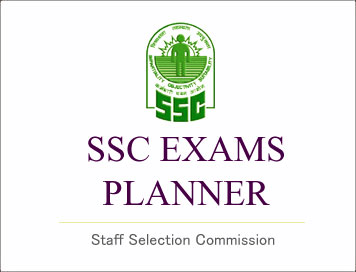
(SSC PLANNER) Functions and Organisational Structure of The
Staff Selection Commission
HISTORICAL BACKGROUND
As per Article 320 of the Constitution, the examinations for
recruitment to all posts and services of the Central Government are required to
be conducted by the UPSC. The Estimates Committee of Parliament in its 47th
Report (1967-68) recommended setting up of a Service Selection Commission for
taking over and conducting examinations for recruitment to lower categories of
posts from UPSC. Pursuant to this, and as an interim measure, an Examination
Wing was added to the Institute of Secretariat Training and Management of
Government of India.
(A) The Administrative Reforms Commission (ARC), in their
Report on Personnel Administration, drew attention to the fact that the bulk of
the staff of the Government at the Centre and in the States belonged to Class
III and Class IV categories. Referring to the identical nature of qualifications
stipulated for entry into such posts in various offices, the ARC advocated
pooling of the requirements of the non-technical posts by different Departments
and selection of personnel either by joint recruitment or through a Recruitment
Board. After a careful consideration of this recommendation, the Government of
India decided to constitute the Subordinate Services Commission vide Resolution
No. 46/1/(B)/74-Estt. `B', dated the 4th November, 1975 (Appendix-A) of
Department of Personnel and Administrative Reforms.
(B) The Subordinate Services Commission was subsequently
re-designated as Staff Selection Commission (SSC) on 26th September, 1977 to
make recruitment to Class III (now Group ‘C’) non-technical posts in the various
Ministries/Departments of the Government of India and their subordinate /
attached offices. The functions of the Staff Selection Commission have been
enlarged from time to time. From May, 1999, the Commission was entrusted
recruitment to all Group ‘B’ posts (non-gazetted) in pay scales the maximum of
which was less than Rs.9300-34800 (Grade Pay Rs.4600) earlier done by the Union
Public Service Commission. From November 2003, the Central Government further
authorized the Commission to make recruitment upto all Group ‘B’ non-gazetted
posts carrying scale of pay of Rs. 9300-34800 (Grade Pay Rs.4600).
(C)The functions of the Staff Selection Commission as per
Resolution No. 39018/1/98-Estt (B) dated 21.05.1999 and its subsequent
amendments vide Resolution No. 24012/8-A/2003-Estt (B) dated 13.11.2003,
29.09.2005, 14th January 2011 and 24th July, 2012 are given as under:-
(a) (i) To make recruitment to Group ‘B’ (non-gazetted) posts
and Group ‘C’ (non-technical) posts under Government of India and their Attached
and Subordinate Offices, except those posts which are specifically exempt from
the purview of Staff Selection Commission in Pay Band-2 and Pay Band-1 carrying
Grade Pay of Rs.4800/- through conduct of competitive examinations.
(ii) To make recruitment to such posts under Government of
India by selection through interviews, in Pay Band-2 and Pay Band-1 carrying
Grade Pay upto Rs.4800/- which may, at the discretion of the Commission, be
preceded by short listing or skill test.
(iii) To conduct Limited Departmental Competitive Examinations of the Central
Secretariat Clerical/Stenographers Services and such other Services as have been
or may be entrusted to the Commission
(iv) To conduct periodical skill tests in English/Hindi and such other skill
tests as may be assigned by the Government from time to time.
(v) To perform such other functions as may be entrusted to it by the Central
Government from time to time.
(b) To conduct examinations and/or interviews, whenever required, for
recruitment to the posts within its purview.
ORGANISATIONAL STRUCTURE OF STAFF SELECTION COMMISSION
The Staff Selection Commission is headed by a Chairman of the
rank and status of Secretary / Additional Secretary to the Government of India.
He is assisted by two Members of the rank and status of Joint Secretary to the
Government of India and other Officers and supporting staff. The sanctioned
staff strength of the Commission in its Headquarters at New Delhi and Regional
and SubRegional offices as on 31.03.2016 was 503. The sanctioned strength
consists of 43 Group ‘A’ posts, 192 Group ‘B’ posts and 268 Group ‘C’ posts. Out
of the total strength of 503 employees, 219 (43.54 percent) are at the
Headquarters
Distribution of sanctioned posts amongst
Regional/Sub-Regional offices is 39 in Central Region, 43 in Eastern Region, 24
in Karnataka and Kerala Region, 43 in Northern Region, 24 in North Eastern
Region, 37 in Southern Region, 36 in Western Region, 19 in Madhya Pradesh Region
and 19 in North Western Sub-Region.
Details regarding the posts and their scale of pay, and staff strength in
Headquarters and Regional offices are at Appendix-D. The Organisational Chart of
the Commission is given at Appendix-B